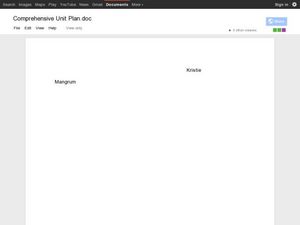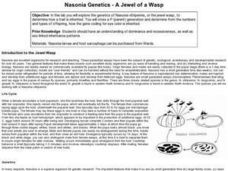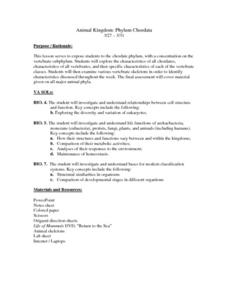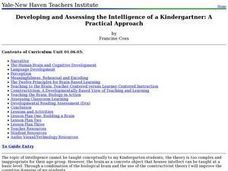Curated OER
The Life Cycle of the Mealworm
Fourth graders provide a habitat for live mealworms and observe their life cycle. In this animal life cycle and scientific inquiry lesson plan, 4th graders create a habitat for a live mealworm and observe and record related data as it...
Curated OER
Water Cycle (Role of Water)
Second graders explore the role of water as a natural resource in order to conserve and protect its use for future generations.
Curated OER
CREATE A NEW RHYME
Third graders develop basic narratives. They retell a focused story and create a basic publication using available resources (e.g., pictures, colors, computer, copier). They experiment with different forms of creative writing (e.g.,...
Curated OER
investigating and Modeling Sea Urchin Fertilization and Development
Students begin by using clay to model fertilization and early development of sea urchins and chordates. They move on to mixing live sea urchin sperm and ova together to observe, diagram and record events occurring in fertilization and...
Curated OER
Nasonia Genetics-A Jewel of a Wasp
Young scholars investigate the inheritance pattern of eye color in Nasonia wasps. For this genetics and inheritance lesson plan, students read about the life cycle of Nasonia wasps and hypothesize about the possibilities of eye color...
Curated OER
Comparative Embryological Study of
Young scholars complete two labs. They observe the fertilization and development of sea urchin and zebrafish embryos. They examine the similarities and differences in the development of an invertebrate vs. a vertebrate animal.
Curated OER
The European Union
Students explore what the European Union is by looking at the historical steps that have revitalized European nations as an economic competitor in global trade. They design three illustrated and comprehensive time line murals to show the...
Curated OER
Earthworms
Fifth graders research the earthworm and write a one paragraph report on its anatomy and habitat. They learn about worms and how to dissect them through Video Streaming and virtual dissections, along with actually dissect a worm as...
Curated OER
Insect Place Mat
High schoolers are introduced to new concepts and vocabulary by using a creative project of making a placemat. The kinesthetic learners will benefit from this kind of project. Also it is great for those who think artistically.
Curated OER
Animal Kingdom: Phylum Chordata
Learners use a dichotomous key to classify various vertebrate jar speciments into classes. They examine the speciments for general characteristics of each class and fill in a corresponding chart and then complete a few final assessment...
Curated OER
Vitamin Planet
Young scholars explain the function of vitamins in their body. In this health lesson, students identify the six types of vitamins. They create a chart comparing two of them.
Curated OER
Who, What, When, Why, And Where?
Students identify and more completely research a historical event that coincides with their own birthday. They then write a report about the event or a person whose birth, death, or life took place within that same timespan and/or...
Curated OER
I Have to Change!? The Role of the Adolescent in the Family
Sixth graders examine the changes occuring during adolescents using children's literature. As a class, they brainstorm a list of the various roles they play in their family. In groups, they use excerpts of plays from Shakespeare to...
Curated OER
Run-on Sentences
Second graders practice using punctuation in run-on sentences. In this punctuation mini-lesson, 2nd graders listen to the book Punctuation Takes a Vacation. They read their own sentences and try to find where they end.
Curated OER
Virginia's Historical Figures
Fourth graders write full paragraphs about important historical figures from Virginia's history. They research an the historical figure before word processing three complete paragraphs using facts and appropriate clipart. They compare...
Curated OER
Collaboration via Slime Mold
Students combine the skills and concepts that they have developed to ask a simple question which can be answered on a Petri plate. They ask questions and design experiments for verification through collaboration with their classmates.
Curated OER
Developing and Assessing the Intelligence of a Kindergartner: A Practical Approach
Students name objects that are the same size, shape, and weight as the human brain. They touch the model brain, feeling the folds, etc. They make connections to the chart displaying the brain-like objects. They touch the 'potato flake'...
Curated OER
Show and Tell
Young scholars practice their speaking skills by sharing information during show and tell about one object. Before giving their speech, they must analyze the relationship and space between them and the audience. They are evaluated by a...
Curated OER
Write A Description
Students practice composing sentences that pertain to the description of a picture. They use critical observation skills in order to derive the best details. The sentences are required to follow the correct subject and verb pattern.
Curated OER
The Mighty Oak
Students investigate types of trees. In this forestry lesson, students read the book The Mighty Oak and act out the story with a partner. Students discuss the types of trees in the book and plant an oak tree on school grounds.
Curated OER
Weather Systems
Fourth graders research weather phenomenon in groups on the Internet and create a slide for the class power point presentation. They include 5 key points (temperature, air pressure, and fronts and descriptions for each type of cloud or...
Curated OER
M&M Exponential Activity
Students create a scatter plot of their experimental data. In this algebra lesson, students use M&M's to determine an algebraic model. They discuss results in class.
Curated OER
Search and Draw
Young scholars research the answer to two science related questions. Using electronic and traditional sources, student research topics related to a science lesson. Answers to the questions are presented through drawings that portray at...
Curated OER
The Lady or the Tiger
Eighth graders make predictions on the topic of a story based on the title and the preview. After reading the story, they analyze what took place and create a graphic organizer explaining what they think would have happened had the...

























